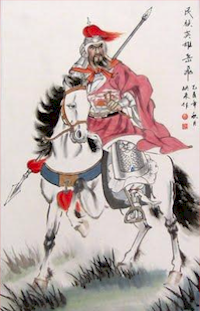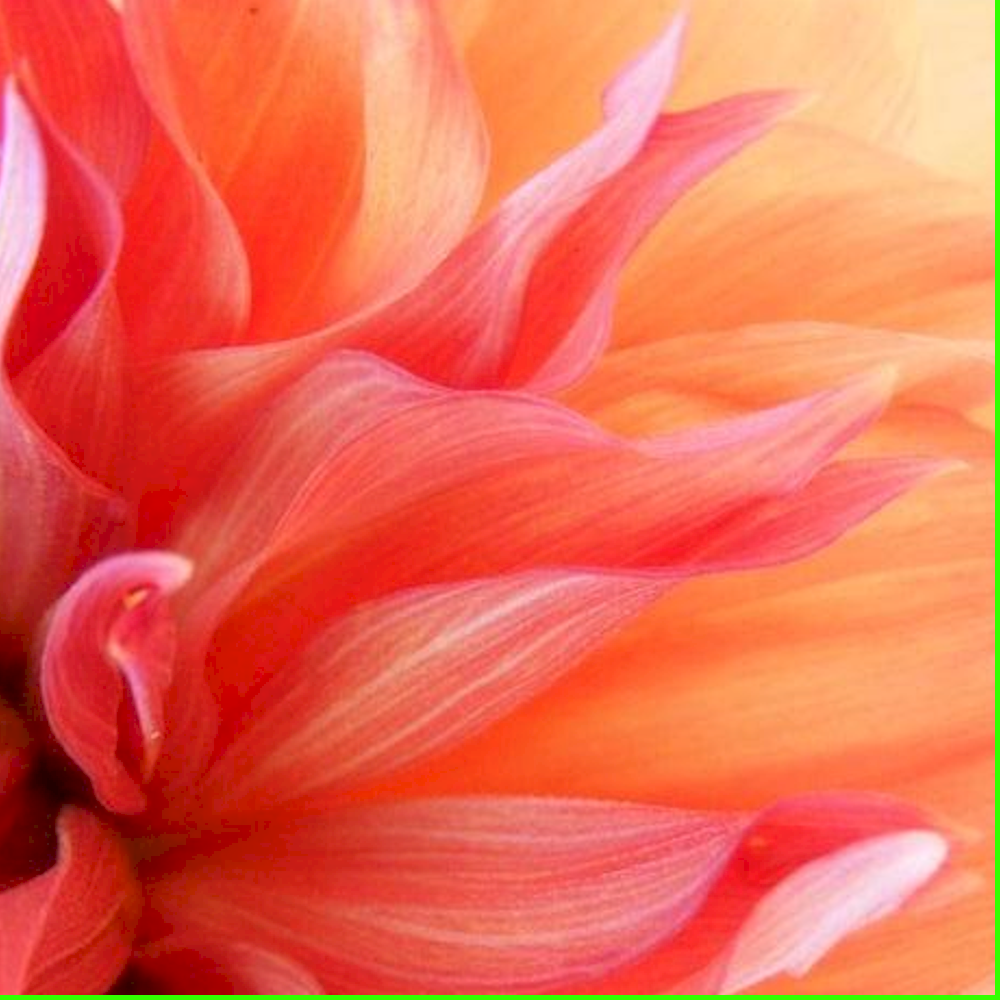|
Qigong

The Eight Pieces of Brocade [ Print PDF ]
Qigong (chee-gung) is the basis of taiji.
Qigong is the Mandarin Chinese term used to describe various Chinese systems of physical and mental training for health, martial arts, and self-enlightenment. It literally means, “breath work.” By concentrating on the breath qigong engages the mind to train the body to relax.
The Eight Pieces of Brocade (ba duan jin) is a simple set of qigong exercises created by General Yue Fei in the 12th century to help maintain the energy, flexibility and health of his soldiers. Various versions of these exercises are still practiced today by everyone from Shaolin Warriors to little old ladies getting over a cold.
Flexibility, combined with a state of alert relaxation, allows the body to perform at optimum levels, reducing stress and injury; and, when the body has been injured, qigong assists in the healing process.
Practice Points
-
Touch the tip of your tongue to the roof of your mouth behind your front teeth, and close your lips lightly. This is important for qi flow.
-
Breathe slowly and deeply, but naturally. Do not try to force your body to comply with the breathing instructions. As you continue practice, breath control will come more easily and you will achieve aerobic benefits.
-
Relax your whole body during practice, and perform all moves as if you are moving through water, feeling the resistance. Effortless effort.
-
Reps: Each “rep” is a right/left or up/down set. 12 reps of each of the exercises from Preparation through the 8 named exercises is usual.
Wuji Stance
Stand straight, feet shoulder width apart, arms hanging at the sides. Bend the knees slightly and tuck the tailbone under so that the spine is straight from butt to head, like an axis for the torso to turn on. Imagine the head is suspended, hanging from the sky by an unbreakable thread. Balance your weight evenly on your feet, imagining that they are growing roots deep into the ground.
Ma Bu (Horse Stance)
Same upper body position as wuji, with feet placed two shoulder-widths apart, toes pointing slightly outwards. Bend the knees as deeply as you can up to the point the thighs are parallel to the floor.
The Warrior Set
Preparation: Willow in the Wind
Wuji stance.
Imagine that the wind blows from behind you catching your palms blowing your arms up to shoulder height. When the wind subsides, your arms float back down to your sides.
Inhale as the arms float up; exhale as they float down.
The Eight Pieces of Brocade
1. Two Hands Hold up the Heavens — Wuji Stance
Turn your palms up and bring your fingertips together. Raise hands slowly up, and when they reach chin height, turn them over and continue to extend your arms until your palms are “pushing up the sky.” Rise up on your toes, balancing evenly on the toes, not allowing the feet to roll outwards. Tilt your upper body slowly from the waist, left, then right. Return to center and lower arms, turning hands over at the chin point, and settling onto your heels as hands return to starting position.
Exhale as you rise up; inhale as you come down. Exhale as you lean left or right; inhale as you return to center.
2. Drawing the Bow to Shoot the Hawk — Ma Bu (horse stance)
Make light fists and bring them together, knuckles touching, at chest height. Turn your waist so the upper body is facing left. Stretch out your left arm and look the fist as you turn your torso back to the center, pulling your right elbow back as if drawing a bow. Turn torso to the left again and bring fists together, and turn back to center. Repeat on right.
Inhale as you bring fists together; exhale as you return to center. Inhale as you turn to the side, exhale as you draw the bow.
3. Separate Heaven and Earth — Wuji Stance
Turn palms up and touch fingertips together. Raise hands to waist. Raise left arm up the center of the body turning palm up to “push the sky;” turn right hand palm down to “press the earth.” Bring hands back to center position, change hands.
Exhale as hands move apart; inhale as they come together.
4. Wise Owl Looks Back — Wuji Stance
Turn head to the left and look back. Return to center. Turn head to right.
Variation: Place palms on your back, above the waist. Do head turns.
Variation: Bring arms up to chest height, fingertips touching, as if holding a large ball. Look left and right.
Exhale as you look back; inhale as you return to center.
5. Sway the Head and Shake the Tail — Ma Bu (horse stance)
Place hands on knees, thumbs on the outer thigh. Keep your spine straight. Shift your weight to the left and look left. Shift your weight to the right and look to the right.
Exhale as you shift to the side; inhale as you return to center.
6. Two Hands Hold the Feet — Wuji Stance
Raise hands to “push the heavens” position. Keep them in position as you drop your head and bend your body forward, vertebra by vertebra, until the top of your head is pointing directly at the ground Grasp your ankles and gently pull in to stretch the back of the legs. Let go, and let your arms dangle as you roll up, vertebra by vertebra, to wuji position.
Exhale as you raise your arms; inhale as you bend forward. Exhale as your pull your ankles; inhale as you return to wuji.
7. Punch with Fiery Eyes — Ma Bu (horse stance)
Make fists and hold them, palm up, at either side of the waist. Turn waist to the left, and punch with the right fist, turning it palm down. Return to center, retracting fist. Turn right, punch with left. Variation: From wuji stance, alternately punch forward to center. You can also kick with same or opposite side foot.
Variation: Punch, then open the hand by fanning the fingers outwards, pinky first. turning the hand palm upwards. Close the hand and imagine you have grabbed something heavy. Now pull the hand back to position at the waist, feeling the resistance.
Exhale as you punch; inhale as you return to center. Be sure to glare at your imaginary opponent — but remain relaxed!
8. Prime the Pump for the Bubbling Well — Wuji Stance
Rise up on your toes about an inch to put your weight on your “bubbling wells,” the points on the soles centered behind the balls of the feet. Hold for a moment, then drop onto your heels heavily, giving yourself a comfortable “jarring.”
Variation: Place palms on your back, above the waist. Rise and drop.
Variation: Bring arms up to chest height, fingertips touching, as if holding a large ball. Rise and drop.
Exhale as you rise; inhale as you drop.
Closing Form
Wuji stance. Place hands on belly, one on top of the other, just below your waist. Feel the top of your head connecting to the sky… feel your feet growing roots into the ground... feel the qi flowing through your body...
Breathe naturally. Meditate for a few minutes if you wish.
Additional Exercises
Circle the Earth
Ma Bu (horse stance).
Left hand on hip, extend right hand down, palm out fingers pointing at the ground between feet. Circle right hand to left (clockwise), keeping palm out; at bottom reverse and circle counterclockwise. Change hands. Weight is centered to begin, shifts deeply from side to side with the hand.
Great Bear Swims
Ma bu (horse stance).
Bring body up by straightening legs, but keep a little bend in the knees. Touch fingertips together, then curl fingers upwards, backs of fingers touching, moving hands upwards and you sink you body down. When hands are at chin height, turn palms outwards, fingertips still touching, and send hands outwards a if preparing for a dive. circle hands outwards as if swimming the breast stroke. As the hands move downwards, allow your body to rise as if coming up out of the water. When hands reach the bottom of the circle, bring fingertips together and repeat.

|

